While eating fruits, we encounter the seeds, right? Some are one seed fruits while some contains many seeds. Do you know why this happens and what are the names of one seed fruits? If you wanna know, just read this article to clear all your queries.
Fruit is a fleshy, plumpy or dry seed-bearing structure typically sweet or sour in taste developed from the maturation of the ovaries after flowering. Simply, it is the matured ovary produced after reproduction mostly edible in nature. On the other hand, Seed is a fertilised mature ovule or embryonic plant which germinates into a new seedling, usually possessing some stored food materials as endosperm. The formation of seeds indicates the completion of sexual reproduction in flowering plants. They are formed from the ovules inside the ovary of the female plant structure. Typically, the steps of seed formation includes:
- Pollination
- Formation of the pollen tube
- Fertilisation to form zygote
- Lastly, Formation of a cotyledonous embryo or Seed.
The seed formation is followed by germination and then the development of a whole new plant under favourable environmental conditions. The seeds of different plants vary according to their shape, size and colour. It consists mainly of 3 parts: Seed coat, Endosperm and Embryo.
The outermost hard protective covering is known as seed coat. It has two layers called testa and tegmen.
The main function of a seed coat is the protection of seeds from unfavourable conditions. The part where nutrients are stored to support embryos during germination is called endosperm. It constitutes a major portion in most of the seeds.
It is the most important part formed after the fertilisation which later grows into a new plant. It is diploid in nature and comprises following parts:
- Epicotyl: Gives rise to new plant shoot system.
- Hypocotyl: Helps in anchorage of plants in the soil.
- Radicle: Embryonic root.
- Plumule: Embryonic shoot.
- Cotyledon: Nourishment to developing embryos. Seeds are classified as monocotyledonous and dicotyledonous based on the number of cotyledons present.
The number of seeds varies according to the fruits. In botany, the fruits having single seed are named as drupe fruits. While the ones with multiple seeds are given names like berries, pepos, aggregates, pomes, etaerios, amphisarca, hesperidium, etc.
Advantages Of One Seed Fruits
- No extra effort is required while eating.
- Since the size of a single seed is quite big, the fleshy or plumpy edible part of fruits can be easily separated from the seed.
Disadvantages Of One Seed Fruits
- The investment of nutrients per seed is higher in single seeded fruits than many seeded fruits.
- The opportunity to reproduce is higher in multiple seeded fruits.
- Some of the seeds may germinate and reproduce despite unfavourable conditions.
Reasons For Having One Seed
As we mentioned above, seed is the developed form of ovules inside the ovary formed after reproduction. The number of ovules vary according to the fruit plants and so does the number of seeds produced from them. So, the reason for having a single seed is the presence of a non-locular single ovule inside the ovary.
One Seed Fruits Name List With Pictures
In this article, we’ll be learning about some of the most popular one seed fruits along with their important characteristics and benefits.
1. Mango: Mangifera indica
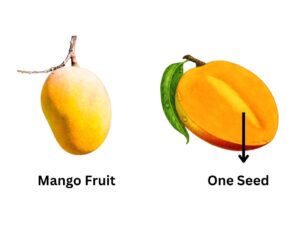
Mango is one of the delicious fruits of commercial importance in the world market . It is entitled as “ King of tropical fruits” due to its high palatability, medicinal and nutritive values, excellent flavour, best taste and attractive fragrance. It is grown in tropical climates popularly in south east asian countries. It becomes a rich source of carbohydrate on ripening. It provides Vitamins A, C, K and B complex. It helps to boost immunity power, maintain healthy eyes, encourages hair growth, improves brain health, reduces the risk of cancer and also can help treat digestive problems like constipation. The ripened mangoes are also used in preparation of canned mango slices, squash, jam, beverages, custard powder, nectar, cereal flakes, baby food, etc. The acidic unripe fruits are used in pickles, powder, flakes, chutney and culinary purposes.
Being a deep rooted tree, it needs a soil profile of at least 2m depth. It thrives in alluvial, well drained and slightly acidic soil. A highland exposed to sunlight and air flow should be selected for an orchard site. It is propagated by different grafting techniques like Inarching, veneer grafting, epicotyl grafting and air layering. There are more than a thousand varieties of mango produced locally or by hybridization. Varieties like Discoehuelo, Chino, Mamy, Carazan, Haden, Kent, Kietta are popularly grown in the USA. Some important commercial cultivars of mango include Langra, Dashehari, Fazli, Bombay, Alphonso, Zardalu, Neelum, etc. We should look out for pests like mango hopper, mealy bug, fruit fly, stone weevil, stem borer, termites etc. and diseases like Powdery mildew, anthracnoses, leaf blight, canker, dieback, etc.
2. Avocado: Persea americana
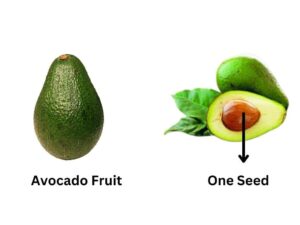
Avocado is a green pear-shaped, spherical or egg-shaped commercially valuable single seed fruit grown in tropical and mediterranean climates. Mexico is one of the leading producers of avocados. It is gaining high popularity due to their high nutritional and medicinal values. It is a low-carb diet rich in unsaturated fatty acids. It is the source of important vitamins like vitamin C, E, K and B6. They help stabilise your sugar level, maintain circulatory system, help lower cholesterol, improve appetite, maintain healthy eyes,etc.
It is propagated mainly by grafting to maintain consistent fruiting. However, it can also be easily propagated from the seeds and grown as a decorative indoor houseplant. It is partially self-pollinating due to dichogamy. It is sensitive to frost and high wind. It needs 3 times more water than apples. It is a climacteric fruit and is harvested after maturity without ripening it.
3. Litchi: Litchi chinensis

Litchi is another one seed fruit which is a juicy evergreen tree that originated in the tropical and subtropical regions of south china. China is the leading producer of litchi. It has brown egg-shaped seed covered by white juicy flesh followed by covering with roughly textured small sharp protuberances which become reddish on ripening. It is rich in vitamins especially vitamin C, minerals and antioxidants with minimal amount of calories and trace amounts of fat. It also contains dietary fibre which helps in weight loss. It also improves heart, liver and brain health and is effective against diseases like cancer, obesity and diabetes.
It prefers high heat, humidity and rainfall and thrives best in slightly acidic well-aerated soil rich in organic matter content. It is propagated most popularly by air layering.
4. Plum: Prunus sps.
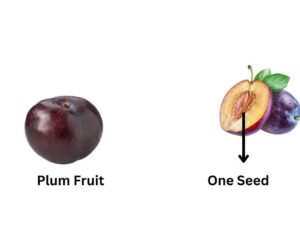
Plum is a diverse one seed fruit of medium size grown in different parts in different seasons. It has firm and juicy flesh enclosing a hard fruit stone. The fruit’s peel is smooth, with a natural waxy surface that adheres to the flesh. Its dried form is called prunes. It is famous for its diversity and nutritional values. It helps solve digestive disorders by monitoring the functioning of the digestive system and relieving constipation.It has antioxidants which prevent cholesterol oxidation and enhances cardiovascular health by preventing free radicals. It also provides efficient protection against cancer cells. Furthermore, it boosts up health cholesterol level, manages heart rate, blood pressure and abate platelet clotting.
It can be propagated by seeds or by grafting. The European plum trees grow in most climates. Japanese plum trees require a warmer climate and American plum trees, being hardiest, can survive even in cold and harsh conditions. The site with well draining soil and provision of direct sunlight for about 6 to 8 hours every day is chosen to prepare orchards of plums.
5. Apricot: Prunus armeniaca

Apricot is the national fruit of Armenia. It has yellow to orange smooth covering slightly tinged red on the side exposed to direct sun. The leading producer of Apricot is Turkey. Its taste ranges from sweet to tart. The dried apricot is very popular because of its taste, high content of dietary fibre and relatively low glycemic index plus low calorie. Three medium sized apricots contain around 60 calories only. It has many potent antioxidants including beta carotene and vitamins A, C and E. When apricot is dried its relative concentration of nutrients is increased along with vitamin A, E, potassium and iron. It contains various phytochemicals like provitamin a beta carotene and polyphenols including catechins and chlorogenic acid. It has health benefits like lowering inflammation, treatment of constipation and help in body and muscle growth. The Japanese apricots are usually used for ornamental purposes.
It requires a chilling temperature and can tolerate winter temperatures as cold as -30 degree celsius. However, the dry climate is good during the maturation phase. It is propagated by grafting and grown in places with cold winters and short dry springs.
6. Cherry
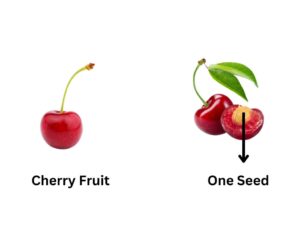
Cherries are small sized fleshy reddish drupe with a unique sour-sweet flavour. It is grown in all areas with less severe winter temperature and moderate summer temperatures. Turkey is the leading cherry producer. It is low in calories and rich in vitamins, minerals, fibre, anti-oxidants like beta-carotene and anti-inflammatory compounds. It helps maintain cardiovascular health, improves sleep quality, reduces symptoms of arthritis and gout and helps fight against diabetes. It is considered one of the best energy boosting fruits and has a relaxing effect on your mood. It also provides relief to induced muscle pain and damage induced after exercises.
7. Peach: Prunus persica
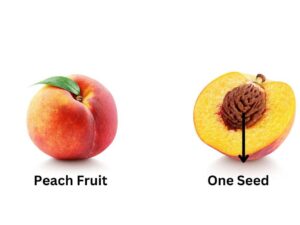
The Peach is a deciduous fruit originated from China covered with fuzzy structures. The fuzz is the protective covering which guards against insects, rot, fungus and even helps lock in the moisture inside. A peach tree can be productive for about 20 to 25 years. It needs chilling temperatures to stimulate fruit growth but is sensitive to frost. It is self pollinating and rich in vitamin C. It helps to heal wounds and improves the immune system. It is rich in vitamins, minerals and antioxidants. It provides health benefits like aid in digestion, skin protection, improves heart health, reduces allergy, anti-cancer properties, lowers blood sugar levels, etc.
8. Olive: Olea europaea
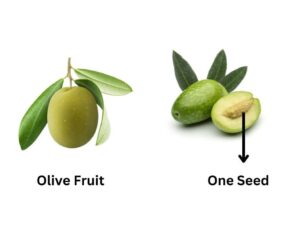
Olive is a little oval-shaped thin-fleshed small drupe fruit. It tastes salty to mild and sweet but very bitter when raw. It is an evergreen tree with agricultural importance found traditionally in the Mediterranean basin. It is commercially used in the production of olive oil. It prefers hot weather, sunny position without shade and calcareous soil, flourishing best on limestone slopes and crags, and coastal climate conditions.
Olive is one of the greatest nutritionally helpful fruits available. It is rich in vitamins A, E, iron, calcium copper and other antioxidants like oleuropein, hydroxytyrosol, tyrosol, oleanonic acid and quercetin. It lowers the occurrence of health risks like cancer, diabetes, stroke and heart disease. It improves memory and mental behaviour. It boosts up energy and helps delay ageing symptoms. It also promotes weight loss, high in dietary fibre, promote healthy skin and hair and
9. Gooseberry: Phyllanthaceae emblica
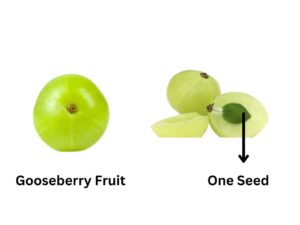
Gooseberry is a smooth light-green coloured round fruit that is called a superfood because of numerous health benefits that it offers to us. It can grow in full sun to partial shade cultivated in tropical to subtropical regions. It has about 20 times higher amount of vitamin C than oranges. It is an absolute immunity booster and helps keep away cold, cough and respiratory problems. It also has cosmetic benefits like keeping our skin radiant and reducing skin pigmentation. It is also helpful in preventing premature greying of hair. It solves digestive problems because of its good fibre content. It has a mineral called chromium which helps diabetic people in making their bodies more responsive to insulin and thereby also stabilising their blood sugar level.
10. Walnut: Juglans regia
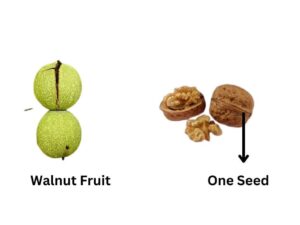
Walnut is one of the oldest tree foods. It is a nutritious snack food sold as whole nuts for cracking or as kernels. Its shape is similar to the human brain. It is grown in temperate climates. It is deep rooted in well drained soil withpH greater than 6. After ripening, its shell is discarded and only the kernel is consumed. It is highly beneficial for health. It is rich in antioxidants, super plant source of Omega 3s, has anti cancer properties, maintains cardiovascular health and improves brain functions and memory power. It prevents coronary heart diseases by favouring a healthy lipid supply. It manages body weight and reduces fats. It has other benefits like boosting bone health, improving metabolism and reducing inflammation.
11. Almond: Prunus dulcis
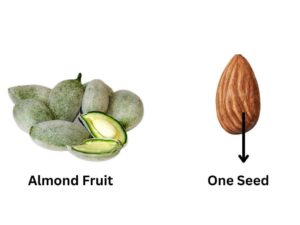
Almonds aren’t a nut but actually a fruit from an almond tree that thrives in warmer but not tropical climates. It belongs to the same families as peaches, cherries and nectarines. The almonds we buy from the market are heat pasteurised. Almonds help in maintaining body weight. It helps in reducing cholesterol and maintaining a fit body. It is popularly consumed in the morning with milk by dipping it in the water all night long and removing the thin brown covering. It is rich in vitamins A, B complex, C, E, magnesium, phosphorus, calcium and potassium. It is very important for diabetes patients and pregnant women. It also prevents dental problems and maintains bone health. It is considered valuable in increasing memory power and brain health.
12. Cashew nut: Annacardium occidentale
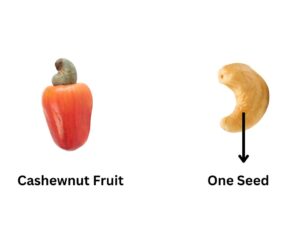
Cashew is a tropical fruit eaten on its own after ripening or processed into cashew cheese and butter.Ivory coast and India are the major producers of cashew nut. It is well adapted to hot lowland areas. It is rich in triglyceride and is not good for heart patients and kidney stone patients. Cashews help lower LDL and increase the capacity for HDL. It helps in avoiding blood disease and maintaining healthy eyes when consumed in limited amounts. Cashew nuts are rich in copper which play an important role in elimination of free radicals from the body. Cashew nut oil is rich in selenium, zinc, magnesium, iron and phosphorus. Also, they are great sources of phytochemicals, proteins and antioxidants.
13. Pistachios: Pistacia vera

It is a tasty and extremely healthy nut in the cashew family that originated from central asia and middle east. It contains the lowest oxalates of all the nuts. It is very high in potassium, phosphorus, magnesium, zinc, vitamin K, B1, B6, C, E and folate. It has low carbs, healthy fats and is a good source of amino acids. It is rich in antioxidants like carotene and tocopherols.
14. Jujube: Ziziphus jujuba

It is also called Chinese dates. It is a small oval shaped drupe fruit which becomes wrinkled looking like dates on maturation. It is a low calorie fruit loaded with dietary fibres, vitamins and minerals. The fruit is consumed raw, pickled, candied or used to make delightful desserts.This wonder fruit delivers tons of health benefits. It helps calming the nervous system and inducing quality sleep. It improves digestion, eliminates several types of cancer and lowers the risk of cardiovascular diseases.
15. Date palms: Phoenix dactylifera
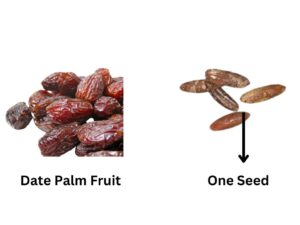
Last in list, Date palms are also one seed fruits. It is an oval-cylindrical with colour ranging from dark brown to bright red depending on variety.It is a tropical crop throughout middle east and north africa and requires well-aerated deep sandy loam alkali soils. It can be consumed by itself or as sweetener or deserts. It is considered very healthy even for heart patients due to a trace amount of fat. It is not recommended for diabetis patients. It is rich in fibre and helps in digestion. It is rich in antioxidants like flavonoids, carotenoids. It reduces ageing symptoms, improves bone health and is good for pregnant women. It is rich in minerals like phosphorus, calcium, magnesium and iron.
Conclusion
In this article, we studied the various types of one seed fruits so called drupe. Almost each of them is rich in vitamins, minerals and antioxidants. They have different health benefits and help in boosting immunity power. These fruits should definitely be considered in our daily dietary food to remain fit and healthy.
